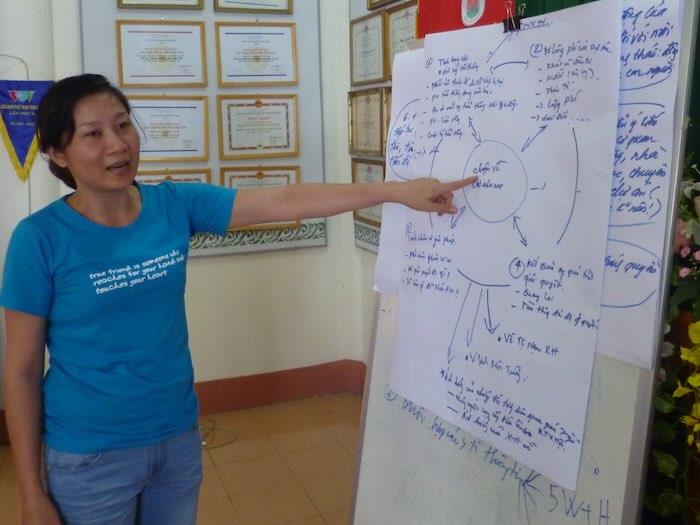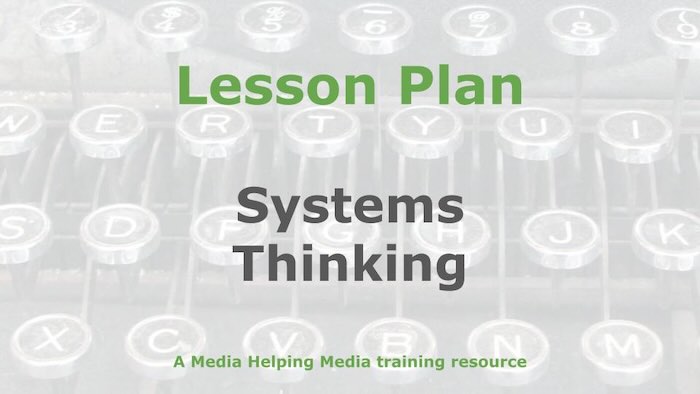 Systems thinking empowers journalists to provide deeper more meaningful news coverage by moving beyond surface-level reporting to uncover underlying related facts.
Systems thinking empowers journalists to provide deeper more meaningful news coverage by moving beyond surface-level reporting to uncover underlying related facts.
Done well, it can lead to a greater awareness of any connected elements which could provide broader context and reveal any important dynamics behind a news story.
News reporting involves far more than providing updates about unexpected and pre-planned events, it also involves investigating beyond what is happening to try to find out why it has happened.
Systems thinking can then help journalists to try to find out how related factors could impact the story and the bearing they have on events. Journalists can use this approach to try to understand the bigger picture behind the news.
In some aspects systems thinking is similar to some of the research methods outlined in two other articles on Media Helping Media, ‘Story development techniques’ and ‘How to develop news angles’.
Both those pieces focus on the need to think through various aspects (angles) of a news story in order to provide the most comprehensive coverage. Systems thinking is about linking those angles to try to find the root cause of the issue being covered.
By using systems thinking, journalists can:
- Find the real causes behind events, not just report what happened.
- Show how different issues are connected.
- Help people understand the news in a deeper way.
- Explaining how the elements of a news story are connected
Shifting focus
Using systems thinking means shifting from reporting events as a solo news story and, instead, looking at the structures and patterns behind those events. This involves:
- Identifying important elements of the story
- Who is involved?
- What laws, policies, or cultural factors play a role?
- Looking at cause and effect
- How do different parts of the story influence each other?
- Are there unexpected results?
- Finding connections
- What things are linked?
- How does one issue affect another?
- Spotting patterns
- Is this part of a bigger trend?
- What forces are driving it?
Examples
- Reporting on homelessness:
- Traditional approach: Focuses on the number of homeless people in a city, perhaps interviewing a few individuals.
- Systems thinking: Goes beyond the surface. It investigates:
- The availability of affordable housing.
- The impact of local economic policies on job availability.
- The effectiveness of social support programmes.
- The role of mental health services.
- This approach shows how homelessness is a result of interconnected factors, not just individual circumstances.
- Covering local pollution:
- Traditional approach: Reports on a spike in pollution levels in the water outlet at a specific factory, perhaps getting a quote from the factory owner and an environmentalist.
- Systems thinking: Examines:
- The regulatory framework for environmental protection.
- The history of industrial development in the area.
- The impact of pollution on the health of local residents.
- The relationship between the factory and local politics.
- This reveals how the pollution is part of a larger system of industrial activity, regulation, and public health.
- School dropout rates:
- Traditional approach: Reports on the percentage of students dropping out of a particular school.
- Systems thinking: Investigates:
- The school’s funding and resources.
- The availability of support services for students facing challenges.
- The impact of poverty and social inequality on student performance.
- The quality of the education being provided.
- The availability of high-quality teaching and support staff.
- This approach shows how dropout rates are linked to a complex web of educational, social, and economic factors.
Guide
Here’s a step-by-step approach journalists can follow:
- Define the issue
- What is the problem or event?
- Identify key people & institutions
- Who is involved?
- What role do governments, businesses, or communities play?
- Look for root causes
- What laws, social norms, or policies contribute to the problem?
- Find connections & patterns
- How do different factors relate?
- Are there repeating trends?
- Explore possible solutions
- What long-term changes could prevent this from happening again?
- Explain clearly
- Use simple language, data, and visuals to help people understand the big picture.
Tools
To practice systems thinking all your really need is lots of paper and pens. A newsroom whiteboard is good for this, as are flip-boards with lots of removable sheets and marker pens. Sticky notes are good, too.
If you want to be more professional about it there are several free and premium systems thinking tools that journalists might want to experiment with including Insight Maker, Kumu, Miro, and SageModeler.
Conclusion
Systems thinking helps journalists go beyond surface-level reporting and uncover deeper truths about society. By connecting events to larger trends and structures, they can provide more meaningful news that helps the public better understand the world.
Further reading
The team at Journalism + Design has created a free systems thinking toolkit for journalists based on exercises “developed through years of research and running workshops for news organisations”.
The toolkit contains an introduction to systems thinking for journalists, along with activities and ideas that reporters, editors, and newsroom leaders can use to explore new angles in their news coverage and help them explain complex situations simply and in a way that informs the public debate.

- Question: What is systems thinking in the context of journalism?
- Answer: Systems thinking in journalism is an approach that involves looking at problems by seeing how different parts connect and influence each other, allowing journalists to understand the bigger picture behind news events instead of just reporting isolated incidents.
- Question: How does systems thinking differ from traditional journalism’s approach to reporting events?
- Answer: Traditional journalism often focuses on reporting individual events as they occur, whereas systems thinking journalism delves into the underlying causes and connections between those events, revealing the larger context and patterns.
- Question: What are some key benefits of using systems thinking in journalism?
- Answer: Benefits include: finding the real causes behind events, showing how different issues are connected, helping people understand the news in a deeper way, and avoiding oversimplification of complex issues.
- Question: What are the steps a journalist can take to apply systems thinking to their reporting?
- Answer: The steps include: defining the issue, identifying key people and institutions, looking for root causes, finding connections and patterns, exploring possible solutions, and explaining clearly.
- Question: How does systems thinking help journalists report on a topic such as homelessness differently?
- Answer: Instead of just reporting the number of homeless people, systems thinking journalism investigates factors such as affordable housing availability, economic policies, social support programmes, and mental health services, revealing how homelessness is a result of interconnected factors.
- Question: What is the difference between “angles” in story development and systems thinking?
- Answer: “Angles” in story development involve brainstorming various aspects of a news story, whereas systems thinking involves linking those angles to discover the root causes of the issue being covered.
- Question: What does “shifting focus” mean in the context of systems thinking journalism?
- Answer: “Shifting focus” means moving from merely reporting events to examining the underlying structures and patterns that drive those events, including identifying elements, cause and effect, connections, and patterns.
- Question: What is the ultimate goal of using systems thinking in journalism?
- Answer: The ultimate goal is to help journalists go beyond surface-level reporting and uncover deeper truths about society, providing more meaningful news that helps the public better understand the world by connecting events to larger trends and structures.
- Question: How can systems thinking help journalists avoid oversimplification of complex issues?
- Answer: By exploring the interconnectedness of various factors, systems thinking reveals the complexity of issues. It encourages journalists to look beyond surface-level causes and understand the underlying structures and patterns that contribute to a problem, preventing them from presenting overly simplistic explanations.
- Question: In the context of systems thinking, what does “finding connections & patterns” involve, and why is it important?
- Answer: “Finding connections & patterns” involves identifying how different factors within a story relate to each other and recognising any recurring trends. It’s important because it allows journalists to see the bigger picture, understand how one issue affects another, and reveal the driving forces behind events, leading to more comprehensive and insightful reporting.
Lesson plan for trainers
If you are a trainer of journalists we have a free lesson plan: Systems Thinking which you are welcome to download and adapt for your own purposes.









